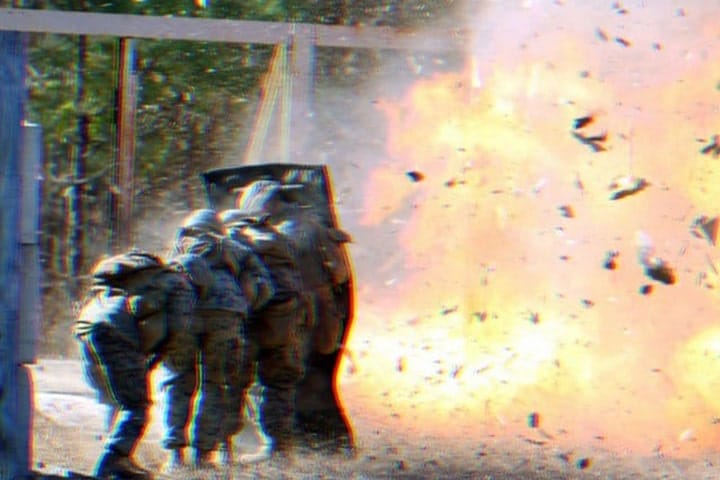
12 Oct Special Ops has a broken culture with explosive breaching that can lead to TBIs
Soldier suicides have been linked to traumatic brain injuries (TBI) which are caused by explosive blasts, whether from IED strikes, firing high-caliber weapons,or working with explosives. While suicides have spiked among special operations soldiers, the military continues to rely on faulty research to study the issue while also misapplying formulas used to calculate minimum safe distances from explosive breaches.
Suicide is an issue that continues to haunt the military, particularly the highly trained and heavily deployed special operations units policymakers increasingly depend upon to prosecute the global war on terror. These service members are now expected to prepare for outright war with so-called “peer adversaries.” Despite millions of dollars spent on soldier resources, training and prevention, suicide rates have continued to increase.
One study commissioned by Special Operations Command (SOCOM) working in conjunction with the American Association of Suicidology (AAS) to analyze special operations suicides concluded that SOF members are 27% more likely to die by suicide than members of the conventional military. The study is titled Psychological Autopsy Study of Suicides Among United States Special Operations Forces.
From a sample size of 117 SOF suicides from 2007 to 2015, the study only examined 29 cases and found that these suicides occur due to, “escalating relationship issues, resulting financial issues, humiliation and lack of use of mental health care.” The study puts the onus back on the soldier rather than examining systemic issues within the military structure itself.
SOF suicides spiked after the study concluded in 2018, reaching 22 deaths that year, while SOCOM continued with the same theme, publicly stating that the deaths stemmed from substance abuse, relationship issues and financial problems.
A SOCOM spokesman told CNN in 2018, “the training we have developed is intended to teach skills that help participants recognize inflexible, rigid thought patterns and to substitute those patterns of thinking with more adaptable thoughts.”
The SOCOM spokesman, “still carries the party line and blamed SOF suicides on service member’s flaws, weaknesses, relationship dysfunction, substance abuse, which are all known outcomes and complications from head injury,” professor and nurse scientist Kate Kemplin told Connecting Vets.
SOCOM’s solution to the suicide issue was to train soldiers to think happy thoughts using positive psychology but Kemplin explained that this just, “alienates people who are different, like people in SOF because they appear deviant from mainstream society” by comparing their results in psychological exams.
However, TBI is a physical injury to the brain. Although it is unseen, asking someone with TBI to “think better” is like asking a soldier shot through the spine to get up and walk.
The study that much of this thinking is based upon uses faulty research standards, lacks academic credibility and it barely makes any mention of TBI. The names of those who ran the study do not even appear on it, only those who conducted the interviews with surviving family members and friends.
Experts in the field of military explosive breaching point out that the calculations and equations used by special operations personnel to understand minimum safe distances from explosive breaches are misused and transformed into pseudoscience, contributing to the rate of TBI.
Those experts point to calculations and methodologies used by SOF to place entry teams near explosive breaches, saying they’re incorrect and negligent. As it stands, current policies are designed to increase the likelihood of soldier traumatic brain injuries.
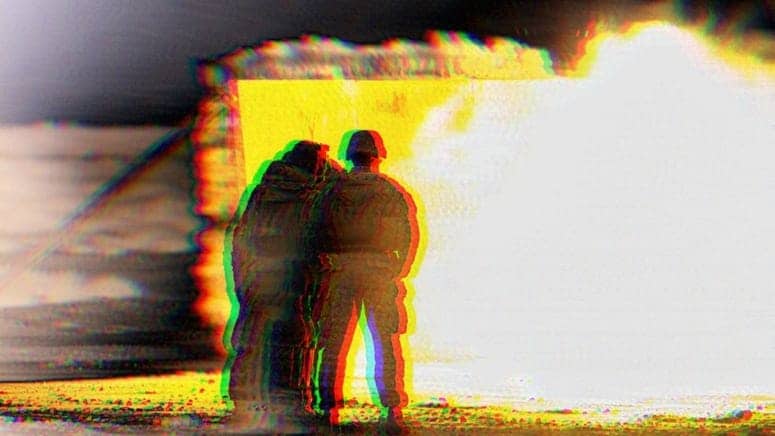
DVIDs, photo by Cpl. Desire Mora
“The methods the lead investigator used directly contradicted the sources they cited,” Kemplin said of the study.
“The psychological autopsies did not follow the methodologies which have been scientifically tested,” Kemplin continued. “They obfuscated and did not explore that 38% of the people in the study had TBI. If 38% of them died and had a common traumatic variable, the study should have been all over that and I don’t understand why the military has not. If 38% of people with any common variable started dying from the same cause, science would be all over it. This speaks to how little we value service members’ lives.”
The study is riddled with basic errors and oversights, Kemplin argued.
“There are standards for reporting research and none of those were followed. To be frank, this study doesn’t meet thresholds I set for my undergraduate research students. They did not follow the methods they described,” she said. “It’s negligent, borders on malfeasance. Even how they calculate suicide and suicide risk for SOF is not accepted methodology. In the study, they didn’t even calculate incidents. They didn’t seem to have a ground-level understanding on how to make epidemiological assessments.”
She pointed out that the causes the study says explain why special operations troops kill themselves are not really causes at all, but rather symptoms.
“Marriage falling apart is an indicator, not a cause,” she says pointing out that you cannot link causes without longitudinal studies. These behavior issues are in many cases related to TBI incurred in combat or during training.
Kemplin was herself married to a soldier afflicted with TBI after an IED strike in Iraq. After they divorced, he took his own life. She had been studying the issue of soldier suicides academically for years prior to his death and first published on the subject three weeks before he died. At the time of his death, he was working for a compartmentalized classified program for the Army’s Intelligence Command (INSCOM) which denied Freedom of Information Act requests regarding his death.
TBI is defined by Warren Stewart and Kevin Trujillo in their paper titled “Modern Warfare Destroys Brains” as, “a traumatically induced structural injury or physiological disruption of brain function, as the result of an external force that is indicated by new onset or worsening of at least one of the following clinical signs immediately following the event: Any alteration in mental status (e.g., confusion, disorientation, slowed thinking, etc.). Any loss of memory for events immediately before or after the injury. Any period of loss of or a decreased level of consciousness, observed or self-reported.”
In regard to how explosive breaching causes TBI, “the level of energy released in a detonation event used in explosive breaching is at a minimum five times higher and faster than released in a pressure explosion event such as a ‘cooker bomb’ or the like which does much of its damage via shrapnel and less due to overpressure and impulse on the victim,” John Scott, a senior staff aerospace engineer with decades of experience in the field of interior ballistics, told Connecting Vets.
“With a detonation event, the impulse applied and transmitted through the victim’s brain is far higher than that of a pressure bomb type device and the damage potential is far higher, that absorption of the shock is what I believe is very detrimental to our soldiers in that their tissues fail instead of bend and give with the energy transmitted through at receipt of the pulse from the detonation,” Scott said.
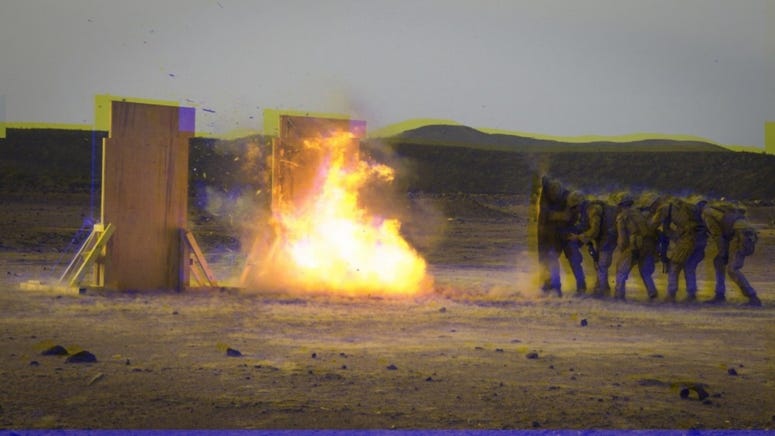
DVIDs, photo by Cpl. Danny Gonzalez
TBI caused by blasts are more complex compared to those from blunt impacts, such as car crashes. TBI caused by an explosion results in “interface astroglial scarring,” which affects brain functions.
Upon autopsying the brains of veterans exposed to blasts, doctors at Johns Hopkins found lesions, “including in the frontal lobes, which control decision making, memory, reasoning and other executive functions. The lesions may be fragments of nerve fibers that broke at the time of the blast and slowly deteriorated, or they may have been weakened by the blast and broken by some later insult like a concussion or drug overdose.”
Symptoms of TBI include, “sleep disorder, decreased cognition, depression, suicidal ideation, post-traumatic stress disorder, dizziness and tinnitus,” Stewart and Trujillo explain in their paper.
“These symptoms can exacerbate or cause even more problematic issues that include alcohol and opiate abuse, behavioral problems that impact work performance, family dysfunction and, in extreme cases, actual suicide,” the report reads.
The Department of Defense mandated screening for those exposed to blasts and began implementing treatment methods, but military explosive experts contest the notion that service members should be exposed to so many blasts in the first place.
“It is operator culture to automatically assume that appropriate vetting of safety protocol, injury prevention and procedure guidance has been validated before presentation to operators,” Chuck O’Connor told Connecting Vets. “Unfortunately, the evidence validates this is not true.”
O’Connor has 42 years of experience in demolitions and is the author of a textbook on explosive breaching titled “Tactical Explosive Breaching Operations.” A former Navy SEAL, he served as the master breacher for SEAL Team Six, also known as Naval Special Warfare Development Group.
Explosive breaching is a technique used by tactical teams where a specialized explosive charge is placed on a locked or barricaded door, window or wall to blow it open and allow the team to enter and clear the structure. In some cases, mechanical breaching can be accomplished with battering rams or pry bars, but in combat, this can take too long and give the enemy time to prepare to ambush the entry team, so explosives are used instead.
Decades ago, the only units that did explosive breaching were Delta Force, SEAL Team Six and the FBI’s Hostage Rescue Team but by the late 1980s, the capability was spreading throughout the military and law enforcement.
At the time, the minimum safe distances between the tactical teams and the explosive breach were being calculated based on safety guidelines created for explosive ordinance disposal (EOD) technicians to destroy unexploded ordnance (UXO). O’Connor says that using these calculations and applying them to explosive breaching in urban areas has, “proven to be inadequate and dangerous.”
“Operators being diagnosed with TBI from conducting tactical explosive entry as a result of proven misuse of explosive equations or TTP (Tactics, Techniques, and Procedures) development from various urban environment overpressure flow simulation technologies confirms the explosive entry education culture is seriously flawed,” O’Connor said.
The mathematical equations being used to calculate safe distances between explosive breaches and tactical entry teams are being misapplied, O’Connor said. One of those formulas, “the K equation,” was developed to assess structural damage to buildings from blast overpressure, rather than to assess the damage a blast does to a human body. It was also never intended to be applied in an urban environment which includes reflective surfaces. In urban areas, a blast wave can bounce off of walls, floors, ceilings and other surfaces before coming back at tactical entry teams from multiple angles.
“K equation was never intended to be used as the only evaluation protocol for mission essential personnel safe positioning when conducting explosive entry anywhere in an urban environment or during range training as being taught,” O’Connor said, Today, the misuse of the equation is hurting operators and causing TBI.
“I would have to agree with Chuck,” Retired Sgt. Mjr. Mike Vining told Connecting Vets. Vining served as the master breacher for Delta Force after his service as an EOD technician in the Vietnam War. “Especially in training situations. Is it really critical in training to be that close to the breach?”
When Connecting Vets asked Army Special Operations Command about current safety protocols for explosive breaching, a public affairs officer declined to comment beyond stating that, “breaching protocols are sensitive in nature. Any discussion, release or confirmation of them would negatively affect the force and could compromise operations.”
According to O’Connor other equations sometimes used to calculate internal blast overpressure such as Weibull’s equation is also misapplied.
“Weibull’s equation is being misused for guidance to position operators in a confined space with the detonating explosive charge,” he said, as it does not adequately calculate all of the reflective blast waves which bounce off of walls and other surfaces before hitting tactical teams conducting internal explosive breaching in a building.
He points to a still used procedure in which tactical teams using a ballistic shield or blanket will shorten the distance between themselves and the breach point, believing the shield protects them from blast overpressure. He said he witnessed this by the Marine Corps, and a search of the Department of Defense photo archive DVIDs readily shows photo after photo of Marines right on top of an explosive breach while holding a ballistic blanket in front of themselves.
“In spite of documented evidence, that procedure is still being presented in military manuals and confined space detonation reference cards and practiced in many training programs,” O’Connor said.
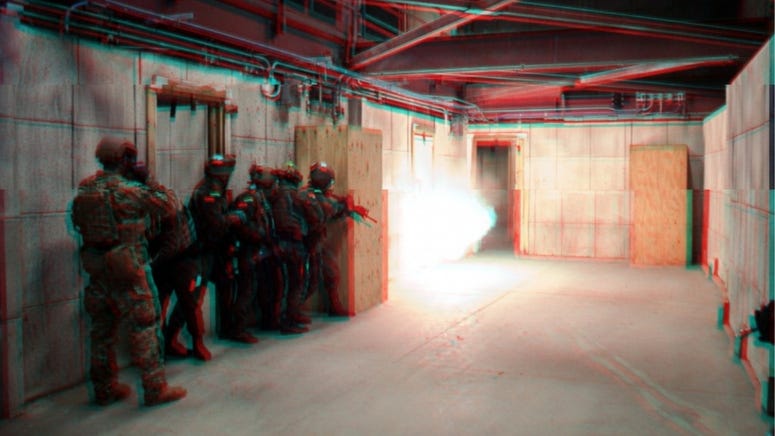
DVIDs, photo by Maj. Thomas Sieslak
Scott believes there are some technological innovations that could decrease the risk that explosive breaching poses for tactical teams, and reduces the number of traumatic brain injuries that occur during their service. He argued the military should first and foremost explore how to reduce the number of explosives used, but that there is another branch of energetics technologies that may also help.
“I would explore the use of completely enclosed thrusting/cutting devices we would attach to the target to break through and essentially launch the target in whatever direction desired, like blowing a door in, without releasing energy externally in the form of a blast wave. These devices have been used since WWII as part of aircraft escape systems and is a huge part of automotive safety via airbag technology,” Scott said, envisioning a device the size of a shoebox that could attach to a door and thrust a piston into it like a battering ram.
“The physics are essentially slow-motion gun ballistics that can be tailored to meet almost any situation. The engineering challenge will be attachment of the device to the structure so it can push the target in the intended direction,” he said. “The energy available is pretty substantial in this type of device in a very small package. Our soldiers could stand very close to a device like this with low risk of injury due to blast effects.”
There is also work to be done to develop better protective equipment for tactical teams. Helmets could be developed that help dissipate blast waves from explosive breaches.
“An effective method to put in would be to use at least three layers of materials with different ‘impedances’ to energy in contact with each other in helmets,” Scott said. “Each layer significantly damps out the energy of incoming blast waves to the head. A corner and spine on a helmet also forces the energy in the blast wave to be redirected and lose substantial energy within the helmet material.
“Additional protection can be placed into the helmet to protect the brain by mechanically locking the helmet, very briefly to a soldier’s torso armor — this prevents the head from whipping and reduces damage caused by internal motion or slosh of the brain,” he added.
There are significant engineering challenges to resolve in order to turn these concepts into useable equipment that soldiers can apply in the field, Scott said, but that making their development a priority in private industry and governmental agencies will ultimately provide better protective gear and breaching equipment for the troops.
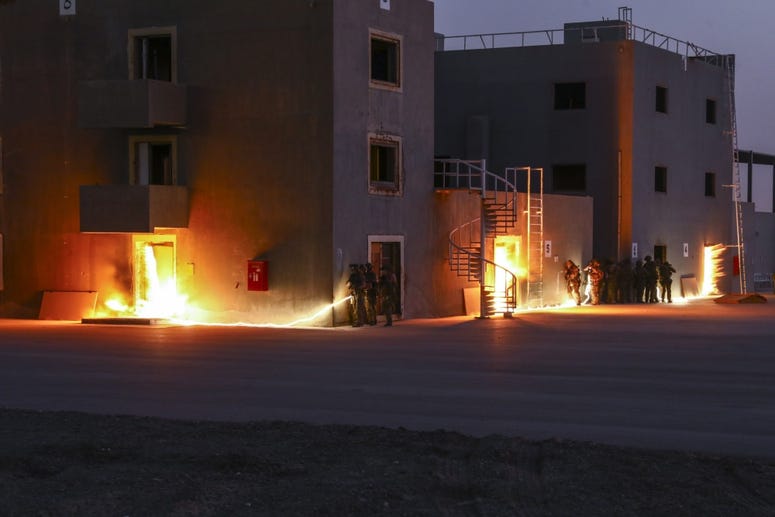
U.S. Army photo by Staff Sgt. Justin Moeller, 5th SFG(A) Public Affairs
Even with technological innovations, O’Connor is adamant that there is no technological solution as long as tactical teams are being trained inappropriately. If explosive entry techniques are abused, then no amount of technology will save operators from injury. It is operator culture itself that has to change, he argued.
Special Forces soldiers, JSOC operators, paramilitary contractors and others who work with explosive breaching spoke to Connecting Vets about “eating charges,” the common practice of setting entry teams right next to the breach point in order to supposedly take advantage of the explosive breach and enter the structure quickly to secure the fundamentals of close-quarter combat: surprise, speed and violence of action.
It is also a notion that some senior combat leaders dispute.
“It is inconsequential if someone got in fast enough,” a recently retired Delta Force sergeant major told Connecting Vets on condition of anonymity. “Unless the bad guy is physically at the door when it goes off. The blast is mitigated by the door and the air gap between him and the door. I’ve seen people fucked up because they were opening the door when it went off but a guy across the room or deep in the house, you won’t get that guy if he wants to kill you. He will close his eyes and lean back on that trigger.”
The retired Delta operator mentioned working with a SEAL unit that explosively breached every door they came to, carrying primed charges in their backpacks on target. They needed to maintain their momentum during the assault with shock and awe tactics, or so they thought. The retired sergeant major conceded that he made mistakes as well when it came to explosive breaching.
“I have been knocked out, I have knocked my guys out” with door charges, he said, adding that it is a misconception that enemy combatants inside the structure will be stunned by the charge. The entry team in the hallway absorbs more of the blast than anyone on the other side of the door.
Some operators say that entering the breach point is a matter of battling the enemy for nanoseconds, but this is also a misconception about what happens on the other side of the breach. While there are some missions of national importance where operators may need to assume additional risk during the breach, these operations are few and far between.
Operators spoke to Connecting Vets about “eating” multiple charges on multiple objectives during a single night and how the explosions were at times so powerful they knocked them to their knees.
“Why are operators allowed to continue using known dangerous practices, creating TBI until these new technologies become available at some undetermined future time? Does this sound logical?” O’Connor asked of current explosive breaching tactics and promises of new technologies on some distant horizon.
What must change he said, is operator culture. Troops are conditioned to believe that explosive breaching has to hurt the operator on the ground, which is not true. As long as dangerous tactics and protocols continue to be used, they will continue to suffer TBI. New technologies, protective gear and explosives can be developed, but if operators continue to abuse those technologies, they will still be hurt by them.
“The solution for injury prevention and safety improvement is and always will be improved education and procedures, not technology,” O’Connor said.
Corrective measures have to be cultural rather than simply technological.
“It is a leadership issue,” the retired Delta Force senior leader said. “Yeah, the system is broken, the science is broken, but at the end of the day, I know a lot of guys who just say ‘fuck that,’” and blow off the safety concerns.
“It is the macho thing to do, to be as close to the breach and get in as quick as possible, but in training is that really necessary?” Vining said.
Even when the correct safety protocols are taught and provided to operators, they are not helpful if they are not applied in training or in combat. At that point, it is incumbent on leaders to enforce the unit’s standards, according to the multiple subject-matter experts Connecting Vets spoke with.

DVIDs photo by Cpl. Thomas Provost
In recent years, Special Operations Command has used blast overpressure meters placed on operators to measure how much they are absorbing.
“We put blast meters on our helmets and we found that rotor wash was tripping the blast meters, so was your M4 rifle,” the retired Delta sergeant major said. “If you sit on the left side of a Blackhawk, it pounds you. At that point our option was, do we stop doing anything? The only way to stop this is to stay home. We turned in our blast meters and they were all pegged.”
The sensors used are not getting readings that accurately reflect the impact of overpressure on the human body to begin with, O’Connor said.
“They put the sensor on your neck or outside your helmet behind you and say this measures the blast exposure to the human brain but it is not even close to recording the real blast impact on the brain,” he said. “The other sensors they place on the chest or shoulder are OK, but the one on the helmet is not an accurate reflection of blast exposure on the brain.”
In regard to sensors placed inside halls or rooms rather than on people, he said “the limitations of these recordings are significant. Researchers and overpressure instrumentation manufacturers incorrectly explain that these sensor recordings represent the entire volume and space for the intent to have operators position in the space with detonating explosives.”
In all of his career, O’Connor said he never met a Ph.D., engineer or other researchers developing minimum safe distance protocols who are willing to place their own body where they said tactical teams should be placed during an explosive breach.
But based on the blast readings they do have, the former Delta Force operator said when it comes to overpressure, there is only one way to totally avoid the problem.
“The only way to mitigate it is to stay home,” he said pointing out that their job involves inherent risk, but that it needs to be managed in a way that is not negligent.
“Urban breaching is so complicated and unpredictable,” Vining said, speaking to the difficulty modeling how blast waves react while explosively breaching. In an urban environment, blast waves reflect off of surfaces and come back at the operators.
“The reflective waves are the tricky ones because they can amplify and merge together to create a stronger force,” he explained.
Considering the numerous challenges breachers across the U.S. military and law enforcement face, you’d hope there would be a governing body, agency or institute to oversee best practices and safety protocols, but as of today, there is not. Each branch of the military follows its own guidelines.
Both O’Connor and Vining advocate for a centralized authority to standardize explosive breaching across the U.S. government.
“I have no problem with that if the national institute of health or whoever can do that,” Vining said. “I think that will help with standards.”
Scott pointed out that in his field in aerospace, specifically the launching of rockets into space, has safety guidelines codified into federal law which must be adhered to.
“This has gone on for decades with no authority that knows how to vet data or give oversight authority. No one is tracking who is doing what. Who is going to be that authority now and how are they going to staff that thing?” O’Connor said. “It should happen, but the question is who will do it?”
Until an oversight committee is established, a broken culture and the misuse of science will continue killing American service members.
This post first appeared here: https://connectingvets.radio.com/articles/outdated-explosive-equations-cause-more-tbis-in-sof-soldiers

